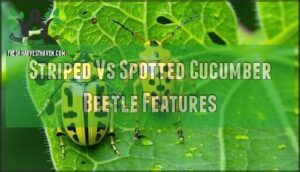This site is supported by our readers. We may earn a commission, at no cost to you, if you purchase through links.
 Row covers are your first line of defense against cucumber beetles. These lightweight barriers let sunlight through but keep the pests out.
Row covers are your first line of defense against cucumber beetles. These lightweight barriers let sunlight through but keep the pests out.
Just remember to pull them off when your plants start flowering—the bees need access for pollination.
Neem oil spray provides effective control when applied correctly, while diatomaceous earth creates a protective barrier around plants. Hand-picking beetles during morning inspections works surprisingly well for small gardens.
Winter cleanup removes overwintering sites, breaking the beetle cycle. Companion plants like radishes can act as trap crops, drawing beetles away from your precious cucumbers.
You’ll get the best results by stacking a few different tactics together.
Table Of Contents
- Key Takeaways
- Identifying Cucumber Beetles and Their Damage
- Physical Barriers for Beetle Prevention
- Cultural Control Methods That Work
- Organic Sprays and Natural Treatments
- Long-Term Prevention and Management
- Frequently Asked Questions (FAQs)
- How do you control cucumber beetle infection?
- What are organic control measures for cucumber beetles?
- What are cultural controls for cucumber beetles?
- Are cucumber beetles a problem in organic farming?
- Do insect pathogens control cucumber beetles?
- Are cucumber beetles safe?
- What kills cucumber beetles naturally?
- Do coffee grounds deter cucumber beetles?
- Does cinnamon get rid of cucumber beetles?
- Will Dawn dish soap kill cucumber beetles?
- Conclusion
Key Takeaways
- Combine multiple methods – You’ll get the best results using physical barriers like row covers, organic sprays like neem oil, and cultural controls together rather than relying on just one approach.
- Start with prevention early – Install row covers immediately after planting when beetles are most active, then remove them when flowers appear for pollination (usually 4-6 weeks after germination).
- Focus on winter cleanup – You’ll break the beetle cycle by removing all plant debris after harvest, eliminating overwintering sites where beetles hide during cold months.
- Monitor regularly for quick action – Check your plants weekly and treat when you find 0.5 to 1 beetle per plant on seedlings with three leaves or fewer to prevent major damage.
Identifying Cucumber Beetles and Their Damage
Proper identification is key to choosing the right organic controls for cucumber beetles.
Striped cucumber beetles display distinctive yellow bodies with three black longitudinal stripes and measure approximately one-quarter inch in length, while spotted cucumber beetles exhibit bright yellow coloration with twelve distinct black spots across their wing covers.
Striped Vs Spotted Cucumber Beetle Features
When identifying cucumber beetles, you’ll notice distinct differences between the two main species. The striped cucumber beetle displays bright yellow coloration with three prominent black stripes running down its back, while the spotted cucumber beetle features yellow bodies adorned with twelve black spots.
Key identification features include:
- Striped cucumber beetle – Yellow body with black longitudinal stripes and black head
- Spotted cucumber beetle – Bright yellow with distinct black spots and yellow abdomen
- Size comparison – Both measure approximately ¼ inch long with similar habitat preferences
Spotting these color differences makes it much easier to tell cucumber beetles apart from look-alikes like western corn rootworms, so you can choose the right treatment approach.
Bacterial Wilt Disease Symptoms
Bacterial wilt disease symptoms start with individual leaves wilting during hot days, especially near cucumber beetle feeding wounds. Early detection involves checking for sticky bacterial ooze from cut stems – a key diagnostic method.
Wilt progression accelerates rapidly in susceptible cucurbit crops like cucumber and muskmelon, with complete plant collapse occurring within 1-2 weeks after disease vectors transmit the pathogen. This disease greatly impacts cucurbit crop yields.
Root and Foliage Feeding Damage
Cucumber beetle damage extends beyond disease transmission to direct physical harm. Adult beetles create feeding holes in leaves, stems, and developing fruit, while larvae attack root systems underground. Seedling vulnerability peaks during early growth stages when defoliation impact can stunt or kill plants.
Key damage symptoms include:
- Larval root damage causing wilting and stunted growth
- Defoliation leading to photosynthesis reduction and weakened plants
- Fruit scarring from adult feeding, reducing marketability
Once you spot these damage patterns, you can pick the right organic controls to stop cucumber beetles in their tracks.
When Cucumber Beetles Are Most Active
Spring’s arrival triggers cucumber beetle seasonal emergence, with peak feeding activity occurring during warm, sunny days when temperatures reach 65-75°F. These pests demonstrate strong diurnal activity patterns, becoming most active during morning hours when dew evaporates.
Weather influence plays a key role in their lifecycle timing, as cool, wet conditions slow their movement while dry heat accelerates feeding behavior.
Getting familiar with cucumber beetle biology gives you the edge in timing your management strategies and knowing when beetle numbers hit action thresholds.
Physical Barriers for Beetle Prevention
Physical barriers offer your most reliable first line of defense against cucumber beetles, preventing them from reaching vulnerable plants during critical early growth stages.
When you layer row covers with reflective mulches and add protective sprays, you’re building a defense system that keeps beetles away during those crucial first weeks when your plants are most vulnerable.
Row Cover Installation and Timing
Floating row covers create an impenetrable shield around your cucurbit seedlings during their most vulnerable weeks. These lightweight fabrics allow sunlight and water through while blocking cucumber beetles completely. Install covers immediately after planting, securing edges with soil or clips. Remove when flowers appear to allow pollination – usually 4-6 weeks after germination.
- Cover Material Choice: Select lightweight spun fabric that allows 85-90% light transmission
- Installation Best Practices: Anchor all edges securely with soil, rocks, or garden staples
- Extended Protection: Leave extra fabric slack to accommodate growing plants underneath
- Pollination Considerations: Mark calendar for removal timing when first female flowers develop
- Removal Timing: Monitor daily for flower buds to guarantee proper bee access for fruit set
Kaolin Clay Application Methods
Properly mixed kaolin clay works like nature’s shield against cucumber beetles when applied correctly. Mix kaolin clay at half a pound per gallon of water using a pressurized hand sprayer. Apply kaolin clay approximately twice weekly early in the growing season for best organic pest control methods. Kaolin clay’s effectiveness stems from its ability to provide natural pest control in gardens.
| Application Factor | Timing | Frequency |
|---|---|---|
| Clay Mixing Ratios | 0.5 lb per gallon | Every application |
| Spray Equipment Choice | Pressurized sprayers | As needed |
| Reapplication Frequency | Early season | Twice weekly |
Yellow Sticky Trap Placement
Around your cucurbit plants, position yellow sticky traps at prime locations to monitor cucumber beetle populations effectively. Set traps at appropriate trap height—18 inches above ground—with proper trap density of one per 50 square feet. Confirm correct trap orientation facing prevailing winds for greatest capture efficiency.
Replace traps weekly during peak beetle season to maintain effectiveness in your organic pest control methods strategy.
Reflective Mulch Benefits
Reflective mulch creates a striking barrier that confuses cucumber beetles through intense light reflection while providing multiple garden benefits.
This organic pest control method disrupts beetle navigation patterns, effectively reducing pest pressure on your crops. The reflective surface maintains ideal soil temperature, suppresses weeds naturally, and often leads to yield improvement in cucurbit plants through enhanced photosynthesis and effective pest deterrence.
Cultural Control Methods That Work
Cultural control methods give you the most sustainable way to handle cucumber beetles without chemicals.
These methods work much better when you combine them with crop rotation, smart planting choices, and companion plants.
Crop Rotation Distance Requirements
Crop rotation breaks pest cycles by moving cucurbit crops at least 500 feet from previous locations. This distance disrupts overwintering beetle range and forces adults to search new areas.
Rotation length effects show three-year cycles work best, allowing soil health benefits while alternative crop families like legumes restore nutrients.
Cultural controls in organic farming systems depend on strategic spacing to heighten rotation distance impact on pest management.
Transplants Vs Direct Seeding
Starting cucumber plants indoors provides a significant timing advantage over direct seeding, giving transplants enhanced root development before cucumber beetle pressure peaks.
Transplant vigor allows cucurbit seedlings reduced exposure to early-season feeding damage when plants are most vulnerable.
This preventative measure for cucurbits requires cost analysis since organic pest control methods like floating row covers become more economical with fewer plants to protect.
Companion Plants That Repel Beetles
Strategic companion planting transforms your garden into nature’s fortress against cucumber beetles. Repellent plant scents from these three allies create powerful intercropping strategies:
- Radishes disrupt beetle host-finding with sulfur compounds, reducing infestations by 50%
- Nasturtiums confuse beetles while attracting predators to strengthen organic pest control methods
- Marigolds improve floral diversity and soil health impact through natural toxin production
Trap Crop Strategies
Smart gardeners deploy attractive trap varieties like Blue Hubbard squash around their main cucurbit crops to intercept beetles before damage occurs. Position these sacrificial plants 20-30 feet from your valuable crops, maintaining proper density and spacing for greatest effectiveness. Continuous trap cropping throughout the season creates a reliable defense system.
| Trap Crop Strategy | Plant Spacing | Beetle Reduction |
|---|---|---|
| Blue Hubbard Squash | 6-8 feet apart | 70-85% |
| Early Summer Crookneck | 4-6 feet apart | 60-75% |
| Acorn Squash Varieties | 5-7 feet apart | 65-80% |
| Zucchini Perimeter | 3-5 feet apart | 55-70% |
| Mixed Cucurbit Border | 4-8 feet apart | 75-90% |
Organic Sprays and Natural Treatments
Sometimes cultural controls just don’t cut it. That’s when you need targeted organic sprays and natural treatments to knock out cucumber beetles for good.
You’ve got several heavy-hitting options: neem oil applications, diatomaceous earth treatments, pyrethrin-based insecticides, and good old-fashioned hand removal. All of these work without trashing your soil.
Neem Oil Application Guidelines
Neem oil provides effective organic chemical controls against cucumber beetles when applied correctly. You’ll need a 0.5-2% neem concentration for best cucumber beetle control. Apply during cooler evening hours to prevent phytotoxicity risks from sun exposure.
Here’s your application strategy:
- Spray timing: Target early morning or late evening when temperatures drop below 80°F
- Application frequency: Reapply every 7-14 days or after rainfall exceeds 0.5 inches
- Weather conditions: Avoid windy days and make certain 24-hour rain-free period post-application
This organic pest control method disrupts beetle feeding patterns effectively.
Diatomaceous Earth Safety and Use
Food-grade DE offers powerful organic pest control against cucumber beetle infestations when applied correctly. You’ll need respiratory protection since inhaling DE particles irritates lungs, even though it’s safe around plants and soil.
Apply thin layers during calm weather using a dust applicator for greatest effectiveness. DE safety tips include wearing masks and avoiding windy conditions. These application techniques promote proper coverage while protecting beneficial insects when used strategically in organic gardening systems.
Pyrethrin-Based Organic Insecticides
Pyrethrin efficacy makes these organic insecticides your go-to weapon against cucumber beetles when other methods fall short. Apply pyrethrin-based products during early morning or evening hours to boost effectiveness while protecting beneficial insects.
These naturally-derived compounds break down quickly in sunlight, requiring reapplication every few days. Rotate with pyrethrin alternatives to prevent resistance management issues from developing in beetle populations.
Hand-Picking and Vacuum Removal
Hand-picking adult beetles into soapy water offers immediate cucumber beetle control when beetle crushing efficacy matters most. Both handpicking and vacuum methods represent cost-effective organic pest control methods for targeted cucumber beetle control.
Insect vacuum units provide greater vacuum suction power for physical removal, particularly effective on trap crops where collection container design allows best removal timing.
Long-Term Prevention and Management
Getting ahead of cucumber beetles means thinking year-round, not just during growing season.
The secret to long-term control lies in three key strategies: thorough winter cleanup practices, choosing resistant varieties, and setting up monitoring systems that catch problems early.
Winter Cleanup to Break Pest Cycles
Breaking the beetle cycle starts with autumn cleanup of your garden beds. Removing plant residue eliminates overwintering habitats where cucumber beetles hide during cold months. These preventative controls form the backbone of organic farming systems and sustainable cultural controls.
- Clear all dead cucumber and squash vines from beds
- Compost diseased material properly using hot composting practices
- Apply soil solarization techniques during late summer heat
- Sanitize all garden tools between different growing areas
- Maintain healthy soil through organic amendments and cover crops
Resistant Cucumber Varieties
Several cucumber varieties offer natural genetic resistance mechanisms against cucumber beetles through reduced cucurbitacin content. Variety trial data shows Fair 83, County Fair, and Ashley cultivars sustain considerably less feeding damage.
Breeding program updates continue developing improved resistance, while consumer preference impact remains minimal since these varieties maintain excellent flavor and yield performance.
Beneficial Insect Conservation
Your garden’s ecosystem works best when natural predators keep cucumber beetles in check. Supporting beneficial insects requires strategic habitat management and reduced spraying practices.
Create predator habitats by:
- Planting diverse flowering plants that attract ladybugs and other natural enemies
- Maintaining pollinator protection zones with native plants throughout your garden
- Providing overwintering sites like leaf litter and brush piles for beneficial insects
Habitat diversity strengthens natural predator conservation strategies year-round.
Monitoring Thresholds for Treatment
You’ll need actionable thresholds to guide your spray timing decisions. Weekly scouting frequency helps track cucumber beetle populations before they reach damaging levels.
For plants with three leaves or fewer, spray when you find 0.5 to 1 beetle per plant.
Damage assessment becomes part of integrated pest management, balancing economic impact with organic pest management strategies that protect your harvest.
Frequently Asked Questions (FAQs)
How do you control cucumber beetle infection?
Looking for a quick solution to cucumber beetle problems? Apply row covers early, hand-pick beetles into soapy water, use kaolin clay spray as prevention, practice crop rotation, and remove all plant debris after harvest.
What are organic control measures for cucumber beetles?
You can control cucumber beetles organically using floating row covers, crop rotation, kaolin clay applications, hand-picking into soapy water, straw mulch, and neem oil treatments for effective management.
What are cultural controls for cucumber beetles?
Ironically, the simplest methods often work best against these persistent pests. Crop rotation, floating row covers until flowering, transplants over direct seeding, and strategic straw mulching around plants will bring you success.
The simplest garden methods often defeat the most stubborn pests through smart crop rotation and protective barriers
Are cucumber beetles a problem in organic farming?
Yes, cucumber beetles are definitely a problem in organic farming. You’ll face feeding damage, bacterial wilt transmission, and potential crop loss without synthetic pesticides for quick knockdown control.
Do insect pathogens control cucumber beetles?
While many growers hope for natural solutions, there’s no evidence that insect pathogens effectively control adult cucumber beetles.
However, parasitoid wasps and tachinid flies sometimes help reduce beetle populations substantially.
Are cucumber beetles safe?
Cucumber beetles aren’t dangerous to humans, but they’re destructive garden pests. They won’t bite or sting you, though handling them might cause minor skin irritation for sensitive individuals.
What kills cucumber beetles naturally?
Hand-picking beetles into soapy water provides immediate control. Diatomaceous earth dehydrates them naturally. Neem oil and kaolin clay repel feeding. Row covers physically block access until flowering begins.
Do coffee grounds deter cucumber beetles?
Coffee grounds may repel some beetles through their strong smell, but there’s no scientific evidence they effectively deter cucumber beetles specifically.
You’ll get better results with proven methods like row covers or kaolin clay.
Does cinnamon get rid of cucumber beetles?
Cinnamon won’t eliminate cucumber beetles effectively. While research shows cinnamon can repel some pests, it’s not proven against these specific beetles and won’t replace proven methods.
Will Dawn dish soap kill cucumber beetles?
Believe it or not, Dawn dish soap won’t actually kill cucumber beetles on contact like you’d hope.
You’ll need stronger organic methods like neem oil, diatomaceous earth, or hand-picking for effective control.
Conclusion
For organic cucumber beetle control, your best bet is using several methods together.
Physical barriers, organic sprays, and cultural practices create a strong defense that protects your crop much better than any single approach.
Keep an eye on your plants and switch up tactics when beetles show up in bigger numbers.
Stick with these organic methods consistently, and you’ll see a real drop in damage without compromising your chemical-free garden. The key is staying persistent and using multiple approaches together.












